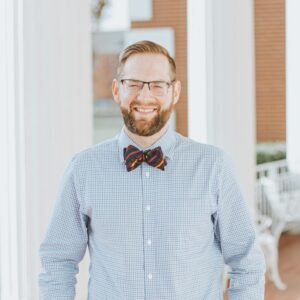
Learning and Teaching Without Walls (Pt. 2)
My fall 2021 “God and the Human Person” students had just read M. Shawn Copeland’s excellent piece “Scripture and Ourselves: Reflections on the Bible and the Body” and were having a rich discussion on the goodness, beauty, opportunities, and limitations of the experience of being “body-persons.”[1] Every time we engage that piece, I am shocked anew when students, especially young women, report that they have never heard that God values bodies and calls us good. Despite what some Christian traditions have held, Copeland reminds us that according to Scripture, according to God, it is good to be body-persons in our particularity.
In the second creation account in Genesis, we read that humans are made from, and made to work, the soil. Our embodiment is good and it is also connected to the dirt![2] During a lull in the conversation I spontaneously walked to the edge of the patio, reached over the red brick wall, and plunged my hand into the flower bed. I pulled out bright yellow and white threads binding the soil and woodchips together: “What is this beautiful structure and what is it doing here?” I asked. It was mycelium, root-like fungal threads—hyphae. Unbeknownst to most, the life and thriving of such organisms are integral in subterranean ecologies and are vital ingredients for what happens above the soil, too. Fungi play a vital role in decomposing organic matter. I replayed that object lesson during Lent this past semester. Such organisms return us to dust, too, giving us back to other creatures (Ecclesiastes 3.20). My outside classroom invited such serendipitous teaching moments again and again during the past two years.
Without a ceiling sheltering us, away from the artificial light of flickering screens and in the blinding brightness of the sunshine, none of us could forget or ignore our embodiment. With no walls the breeze caressed our skin, sometimes a few raindrops threatened to send us scrambling inside. We dressed in layers or brought blankets on cool but warming days. On early fall semester days and during late spring semester days we wore hats and sunscreen or put up shade canopies. Being outside forced us to heighten our attention to the weather and changing seasons to better know our place and its natural rhythms. Even while standing and sitting on a built environment, the brick patio where my class met, being outside literally grounded us. The openness of the classroom to the sky above also signified our capacity for self-transcendence and growth in knowledge of ourselves, God, and God’s world.
Our growth in knowledge of ourselves, God, and God’s world is always embodied, always grounded, of course. But the goodness of that fact, and even the goodness of our limitations, can be communicated outdoors in ways that it cannot be while inside. The week after we talked about embodiment in “God and the Human Person” we discussed interiority, consciousness, and ways of knowing. To exhibit the linkage between inner and outer, consciousness and sensation, most days I played instrumental music at the beginning of classes for prayer time. I invited students to close their eyes, to recall that we are always in God’s presence and that God is for us, and to attune themselves to their breathing, the music, and the sounds of the breeze and birds. The pivot between sensation and inner quiet served the work of attending both to our bodies and our minds.[3]
Some days playing children, noisy lawnmowers, or gusty winds made the planned intellectual work of my classes difficult or even impossible. Despite my frustrations with such “distractions,” each served as a poignant reminder of the privilege of intellectual work, of its value, of its limitations, and of its relationships to “real life.” The “distractions” pressed in on us, and through them God taught me (and my students tell me they are learning this, too,) how we are not objective points, atoms bouncing around off one another, but are enmeshed in communities with other body-persons, communities including other nonhuman creatures, in worlds of meaning shaped by social and cultural assumptions and infrastructures. We always learn our capacities and limitations as body-persons in such communities, after all. My next and final reflection on learning and teaching without walls will explore how being outside helped us to recognize and attend to such communities.
[1] M. Shawn Copeland, “Scripture and Ourselves: Reflections on the Bible and the Body.” America: The Jesuit Review (September 21, 2015).
[2] On how we are “soil-birthed and soil-bound,” see Norman Wirzba, This Sacred Life: Humanity’s Place in a Wounded World (New York, NY: Cambridge University Press, 2021), 65-67.
[3] The first few times that I utilized music for prayer time, though, we dove straight into difficult discussion. I quickly discerned that the transition was too abrupt, akin to emotional or intellectual whiplash! I devised a buffer time of standing and stretching following the music/prayer time and preceding discussion.
Leave a Reply